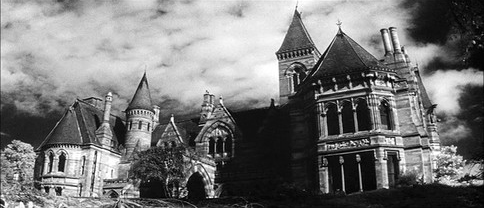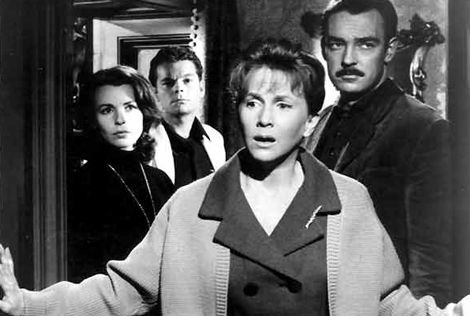|
|
Reviewed by Glenn Erickson
Now that the appeal of torture-chic has waned, horror movies of the last few years have been working overtime trying to find ways to scare people. The fallback subject of the moment seems to be (sigh) Zombies. But conventional haunted house pictures have always found a niche, and this Halloween the top two contenders in the subgenre, historically speaking, are being released on Blu-ray. The Uninvited has always been for connoisseurs, but Robert Wise's The Haunting is still the champion supernatural chill-inducer. When it came out A-picture ghost stories had not been doing very well. Based on a best selling novel, it helped pave the way out of the low budget ghetto for scare shows. Wise uses every trick he learned from his first directing days with producer Val Lewton, and quite a few new ones as well.
It's a gloomy season in New England when an odd trio descends on the reportedly haunted Hill House, invited by Dr. John Markway (Richard Johnson) to find proof of the supernatural. Nervous Eleanor Lance (Julie Harris) won't talk about it, but she was the center of a number of unexplained paranormal events as a child. Hard-edged Theodora (Claire Bloom) is an all-but-confirmed psychic. Along to protect his investment is Luke Sanderson (Russ Tamblyn), the heir to the difficult-to-rent property. It's not long before something in the house makes its presence known - especially to the skittish Eleanor.

The Haunting is certainly much more sophisticated than the average haunted house film circa 1963; there had been good, satisfactory ghost movies before but the only recent production approaching the technical level of this Robert Wise production was Jack Clayton's The Innocents, made in England.
The ghosts manifest themselves only as pounding noises, and an uncanny door that flexes from some unseen force. Yet, among many pictures where the phantoms are clearly shown, this is the picture that more people say gives them the supernatural willies. The general approval of The Haunting runs all the way to horror author Stephen King. His TV movie Rose Red is a quasi-official remake, right down to actually picturing the childhood rain of stones only described here.
Taking the low-key approach, Wise adheres to the Val Lewton formula of suggestion over manifestation, giving us a spooky fun ride of strange sounds and weird things not-quite-seen. The film has a sophisticated audio track, especially for its time. Excellent acting sells us on the basic menace of Hill House, but Wise employs many clever effects, such as visible freezing breath to represent a 'cold spot'. In the scene showing Eleanor's home life, source music is played too loudly over the dialogue, adding to her feeling of oppression.
Wise puts his familiar precise control of angles to good use. The compositions stress the location over the people, dwarfing them in wide shots of ornate rooms, or leaving them off-balance in tilted angles that necessitate our constant re-orientation. Lenses with subtle distortions add to this effect. The lighting is low-key, but not outrageously stylized or expressionist; the rooms are interesting but never pretty. Wise does enforce a strict accounting of spatial relationships, so we always know where people are in relation to each other -- until he wants to trick us.
Wise uses Psycho- like driving POV's for Eleanor, and her hushed, tremulous voiceover helps maintain the mood. Editorially, he keeps things graphic and simple, encouraging us to scan nervous truck-ins on walls, rickety staircases, etc., in search of visible signs of ghosts. It works: in one push-in to a piece of fancy wall decoration, we perceive a ghost-face in the design. After that, we're looking for faces even in the clouds that pass over Hill House. Wise uses his infra-red film stock trick from Odds Against Tomorrow on the house exteriors, to give them a strange look.

More arcane but effective is the Robson-Wise-Lewton editorial trick for dissolves seen in Bedlam. A third, 'phantom' image is introduced in the middle of an otherwise ordinary lap dissolve. It's very effective in the film's flashback prologue, when the film transitions away from a staring corpse.
As this was the first time that a haunted house movie incorporated a 'serious' scientific investigation, audiences took Markway's experiment at face value. How Markway is going to derive anything scientific from this visit isn't clear. He talks about measuring the temperature of the cold spot, but doesn't do it. There are no microphones, cameras, or other recording devices. Does he expect scientists to accept the testimony of his companions? Spielberg and Tobe Hooper upped the ante in 1982's Poltergeist by having their researchers haul in tons of flashy computer equipment.
Eleanor is terribly fragile and unstable. Anyone interviewing her after the fact would conclude that she had experienced hallucinations. Theodora is so manipulative and crafty that anything she might say would be suspect as well. Dr. Markway doesn't qualify as an objective observer either - he's constantly offering supernatural explanations for the phenomena they witness. That leaves young Luke Sanderson, who provides a much-needed grounding in skeptical common sense. 1
Nelson Gidding's screenplay is structured as a slow assault on Eleanor, a defenseless lost soul desperate to escape her smothering family. It's the opposite of Poltergeist, in which the family under attack is both sane and strong, and the threat comes from an exterior "other". Poor Eleanor hasn't a decent family, and her present companions are not really her friends. Luke isn't above making hurtful comments, and the thoughtless Dr. Markway is either dismissive of Eleanor's blatant attraction to him, or doesn't care. If he really believes that Eleanor is so sensitive to the bad vibes in Hill House, he's selfishly cruel to let her stay.

Finally, there's the surprising character of Theodora. It's unusual and progressive for a lesbian to be depicted this overtly in 1963. Her sexual orientation probably eluded many viewers, even after Eleanor calls her 'unnatural'. Theodora's an interesting character who unfortunately reinforces the old assumptions -- she becomes violent at Luke's taunting touch, and puts malevolent twists on all the relationships she sees. She's a psychological predator. Her taunts have the strongest influence on the sensitive Eleanor, who sadly would be a borderline mental case without any supernatural involvement. Neither Markway nor Theodora bother to tell Eleanor that he is married. The arrival of Markway's wife puts Eleanor in a state where the slightest jolt could precipitate a disaster.
The acting is much better than average, even for a Robert Wise film. Powerhouse actress Julie Harris is in tight control of the frantic Eleanor, and Claire Bloom uses her cool authority to good effect. Richard Johnson is much better than in his action and adventure movies (Khartoum). In this serious company, Russ Tamblyn is a pleasant diversion, providing levelheaded reactions to all the portentous dialogue. It's significant that we look to his responses for verification that something impressive is really happening. Everyone else is far too quick to jump to supernatural conclusions, or to simply panic.
The Haunting's real success is its theme of psychological persecution. Seen today, Eleanor is a desperate soul, hungry for human contact. She just wants a normal life, so much so that she foolishly tries to suppress her spooky childhood experiences. If Eleanor runs meekly to her fate, it's because Hill House is the only 'personality' in the film that wants her.
Warner Home Video's Blu-ray of The Haunting is a great improvement over the DVD that came out almost exactly ten years ago. That transfer was dirty and dull, with clogged blacks. This new HD encoding is sharp and exact, and brings out a full range of B&W tones. We can finally see for ourselves how the infrared film stock differs from the normal footage. The ornate interiors of Hill House aren't a blur, but a dense tapestry where something might be hiding. We feel the gloom and the cold and isolation a bit more. And the carefully tuned mono track comes across as a different item in lossless HD, rich and detailed.
The best extra from the old DVD has been retained, a commentary track with director Wise, all four key actors and screenwriter Nelson Gidding. Wise is animated and quick to tell all his secrets; it's one of his best commentaries. Julie Harris tells us that she envisioned the Eleanor character differently, but played it Wise's way. Nelson Gidding and Richard Johnson are enthusiastic as well. Claire Bloom talks about playing 'a woman attracted to a woman' and explains that Harris avoided a friendship during filming to maintain friction between their characters. Russ Tamblyn excitedly tells of a ghostly experience he had while making the film in England. Wise and Johnson are heard the most, while the women and Tamblyn make much smaller contributions.
A trailer is the only other feature, but the commentary is more than enough. Warners' Blu-ray of The Haunting will help to make this Halloween a special season for horror film fans.
On a scale of Excellent, Good, Fair, and Poor,
The Haunting Blu-ray rates:
Movie: Excellent
Video: Excellent
Sound: Excellent
Audio: English, German, Spanish (2), Portuguese.
Supplements: Commentary, original trailer.
Deaf and Hearing Impaired Friendly?
YES; Subtitles: English, French, German, Spanish, Portuguese.
Packaging: Keep case
Reviewed: October 12, 2013
Footnote:
1. A college friend of Savant was a cameraman who got a part-time job filming 'phenomena' for a bona-fide parapsychological researcher at UCLA, Thelma Moss. After an initial interest in the Kirlian photography craze, he became quite disillusioned dubious kooks he filmed. Almost everyone interviewed had 'enablers' working like frontmen to verbally convince the researcher that the paranormal was real. My friend filmed telekinesis gurus who kicked the table to get things to move. "The spoon was bending by itself until just before you got here, honest" was the famous line I remember. Remembering my friend's experience made seeing Ghostbusters all that much more fun -- especially when the bogus researchers get kicked off campus as frauds!
Just the same, one of the investigations -- in which my friend participated -- became the basis for the film The Entity. I write more about his experiences there.
Return

DVD Savant Text © Copyright 2013 Glenn Erickson
See more exclusive reviews on the Savant Main Page.
Reviews on the Savant main site have additional credits information and are often updated and annotated with reader input and graphics.
Also, don't forget the
2011 Savant Wish List.
T'was Ever Thus.
Return to Top of Page
|

